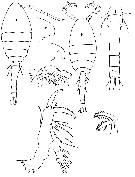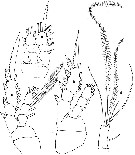|
|
 |
|
Cyclopoida ( Order ) |
|
|
|
Oithonidae ( Family ) |
|
|
|
Oithona ( Genus ) |
|
|
| |
Oithona colcarva Bowman, 1975 (F,M) | |
| | | | | | | Syn.: | Oithona brevicornis : Fish, 1925; Wilson, 1932 (p.46, figs.F,M); 1932 a (p.315, figs.F); Deevey, 1948; 1952; Grice, 1960 a (p.487, figs.F); Anraku, 1964 (p.49) | | | | Ref.: | | | Bowman,1975 (p.134, figs.F,M); Fonseca & Björnberg, 1975 (1976) (p.130); Shuvalov, 1980 (p.140, figs.F,M); McKinnon, 2000 (p.108, Rem.) |  issued from : T.E. Bowman in Chesapeake Sc., 1975, 16 (1). [p.135, Fig.1, a-h]. Female (from Long Point: Patuxent River: a, habitus (dorsal); d, forehead (lateral); e, head (ventral); f, urosome (dorsal); g, Md; h, Md (setae of the 2nd basipod). Nota: 2nd basipod of Md bearing 2 blunt setae armed with marginal setules; endopod with 5 setae. A1 reaching posterior margin of 2nd pediger segment. Rostrum ponted in lateral view, rounded in ventral view. Male: b, habitus (dorsal); c, forehead (lateral). Nota: Rostrum shorter and blunter than in female
|
 issued from : T.E. Bowman in Chesapeake Sc., 1975, 16 (1). [p.136, Fig.2]. Female: a, P1; b, P2; c, P4; d, caudal ramus (ventral view).
|
 issued from : G.D. Grice in Bull. mar. Sci. Gulf Caribb., 1960, 10 (4). [p.486, Figs.1-6]. As Oithona brevicornis. With doubt. Female (from NE Gulf of Mexico: off Alligator Harbor): 1, habitus (dorsal); 2, forehead (lateral); 3, P1; 4, P2; 5, P3; 6, P4.
| | | | | Compl. Ref.: | | | Lonsdale, 1981 (p.333); Ohlhorst, 1982 (p.1, Table I, II, fig.4, 5, 6); 1985 (p.101); Ohlhorst & Liddell, 1985 (p.117); Mallin, 1991 (p.481); Madhupratap & al., 1991 (p.947, Rem.: p.956); Roman & al., 1993 (p.1603, Oxygen effect); Uysal & Shmeleva, 2012 (p.909, Table I); Zamora-Terol & Saiz, 2013 (p.376, Rem.: Table 3, egg production); Barton & al., 2013 (p.522, Table 1: metabolism, feeding mode, biogeo). | | | | NZ: | 3 | | |
|
Distribution map of Oithona colcarva by geographical zones
|
| | | | | |  Issued from : S. Zamora Terol in Tesis Doc. Univ. Politèc. Catalunya, 2013 [p.82-83, Table 3]. Issued from : S. Zamora Terol in Tesis Doc. Univ. Politèc. Catalunya, 2013 [p.82-83, Table 3].
Comparison of egg production and clutch sizes among different species of Oithona from field and lab studies.
a: total length; c: clutch size estimated from hatched nauplii; d: maximum specific-egg production rate.
Also, see: Oithona attenuata, O. aruensis, O. davisae, O. nana, O. plumifera, O. setigera, O. similis, O. simplex. |
| | | | Loc: | | | Gulf of Mexico - Chesapeake Bay - Cape Cod, Jamaica, E Medit. (N Lebanon Basin) | | | | N: | 13 | | | | Lg.: | | | (45) F: 0,75-0,65; (632) F: 0,6; M: 0,55; (633) F: 0,6-0,48; {F: 0,48-0,75; M: 0,55} | | | | Rem.: | Estuaries.
For Bowman (1975, p.134) the common and abundant species in coastal and estuarine waters of the east and Gulf of Mexico coasts of the United States is incorrectly known as Oithona brevicornis Giesbrecht.
See in Oithona robertsoni Table 1 from McKinnon (2000, p.108).
According to Uysal & Shmeleva (2012, p.917) mention this species for the first time in Eastern Mediterranean Sea.
After Ohlhorst (1982), demersal zooplankton reside in or near the reef substrats and usually migrate into the water column at night. The zooplankton into Discovery Bay (Jamaica), rise at variable rates throughout the night, with a peak activity usually during the second hour after sunnset. This temporal pattern is a reflection of the behavior of the dominant (80-90% of night samples) cyclopoid, OIthona colcarva Bowman.
The feeding mode after Barton & al. (2013, Table 1) is 'ambush' (See definition in Rem. Centropages typicus). | | | Last update : 26/10/2020 | |
|
|
 Any use of this site for a publication will be mentioned with the following reference : Any use of this site for a publication will be mentioned with the following reference :
Razouls C., Desreumaux N., Kouwenberg J. and de Bovée F., 2005-2025. - Biodiversity of Marine Planktonic Copepods (morphology, geographical distribution and biological data). Sorbonne University, CNRS. Available at http://copepodes.obs-banyuls.fr/en [Accessed November 09, 2025] © copyright 2005-2025 Sorbonne University, CNRS
|
|
 |
 |






